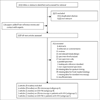Diagnostic accuracy of same-day microscopy versus standard microscopy for pulmonary tuberculosis: a systematic review and meta-analysis
- PMID: 23099183
- PMCID: PMC3836432
- DOI: 10.1016/S1473-3099(12)70232-3
Diagnostic accuracy of same-day microscopy versus standard microscopy for pulmonary tuberculosis: a systematic review and meta-analysis
Abstract
Background: Sputum smear microscopy is the most widely available diagnostic test for pulmonary tuberculosis in countries with a high burden of the disease. Improving its accuracy is crucial to achievement of case-detection targets established by the Millennium Development Goals. Unfortunately, many patients are unable to submit all of the specimens needed for examination or to return for treatment because standard sputum collection and reporting requires several clinic visits. To inform policy recommendations by a WHO-convened Expert Group, we aimed to assess the accuracy of sputum smear examination with strategies for obtaining sputum on 1 day compared with strategies for obtaining sputum over 2 days.
Methods: We did a systematic review and meta-analysis of research articles comparing the accuracy of front-loaded or same-day microscopy and standard sputum smear microscopy for diagnosis of culture-confirmed pulmonary tuberculosis. We searched Medline, Embase, Biosis, and Web of Science for articles published between Jan 1, 2005, and Feb 14, 2012. Two investigators identified eligible articles and extracted data for individual study sites. We generated pooled summary estimates (95% CIs) for sensitivity and specificity by use of random-effects meta-analysis when four or more studies were available.
Findings: We identified eight relevant studies from five articles enrolling 7771 patients with suspected tuberculosis in low-income countries. Compared with the standard approach of examination of two smears with Ziehl-Neelsen light microscopy over 2 days, examination of two smears taken on the same day had much the same sensitivity (64% [95% CI 60 to 69] for standard microscopy vs 63% [58 to 68] for same-day microscopy) and specificity (98% [97 to 99] vs 98% [97 to 99]). We noted similar results for studies employing light-emitting diode fluorescence microscopy and for studies examining three smears, whether they were compared with two-smear strategies or with one another.
Interpretation: Same-day sputum smear microscopy is as accurate as standard smear microscopy. Data from tuberculosis programmes are needed to document the changes required in the health system to successfully implement the strategy and understand its effects.
Funding: WHO and US National Institutes of Health.
Copyright © 2013 Elsevier Ltd. All rights reserved.
Conflict of interest statement
Conflicts of interest
We declare that we have no conflicts of interest.
Figures


Comment in
-
Same-day diagnosis and treatment of tuberculosis.Lancet Infect Dis. 2013 Feb;13(2):102-4. doi: 10.1016/S1473-3099(12)70270-0. Epub 2012 Oct 23. Lancet Infect Dis. 2013. PMID: 23099182 No abstract available.
References
-
- Mase SR, Ramsay A, Ng V, et al. Yield of serial sputum specimen examinations in the diagnosis of pulmonary tuberculosis: a systematic review. Int J Tuberc Lung Dis. 2007;11:485–495. - PubMed
-
- WHO. Reduction of number of smears for the diagnosis of pulmonary TB. Geneva: World Health Organization; 2008.
-
- Katamba A, Laticevschi D, Rieder HL. Efficiency of a third serial sputum smear examination in the diagnosis of tuberculosis in Moldova and Uganda. Int J Tuberc Lung Dis. 2007;11:659–664. - PubMed
-
- Cambanis A, Ramsay A, Wirkom V, Tata E, Cuevas LE. Investing time in microscopy: an opportunity to optimise smear-based case detection of tuberculosis. Int J Tuberc Lung Dis. 2007;11:40–45. - PubMed
-
- Walker D, McNerney R, Mwembo MK, Foster S, Tihon V, Godfrey-Faussett P. An incremental cost-effectiveness analysis of the first, second and third sputum examination in the diagnosis of pulmonary tuberculosis. Int J Tuberc Lung Dis. 2000;4:246–251. - PubMed
Publication types
MeSH terms
Grants and funding
LinkOut - more resources
Full Text Sources
Other Literature Sources

